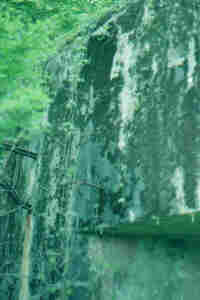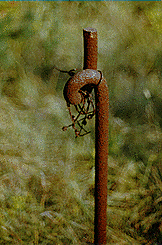The line was named in honor of André Maginot, war hero,
beloved Minister of Veteran's Affairs, and Minister of War
from 1928 to 1932. It could just as easily have been called the "Painlevé Line"
after the Minister of War who was responsible for introducing debate
on the line in Parliament, or the "Pétain Line," after the man who thought of
the concept. But it was named after Maginot, whose contribution was his gift of oration which persuaded parliament,
both the right and the left, to allocate the money for the project.
The Maginot Line was a powerful line of defense which stretched from
Switzerland to the Ardennes in the North, and from the Alps to
the Mediterranean in the South. It was a vast, dynamic, state-of-the-art, ultra-modern defensive system.
Most of its components were underground, where interconnecting tunnels stretched for kilometers, and where,
beneath the earth, thousands of men slept, trained, watched, and waited for
a war that never came.
In the end, the Maginot Line was considered by many to be a failure.
It was powerful and supposedly impregnable, yet it failed to save France
from a humiliating defeat in 1940. But was it truly a failure? The truth is that the Maginot Line
served the exact purpose for which it was built. It dissuaded the Germans
from attacking across France's eastern frontier; it gave the French
Army time to fully mobilize and deploy; and, if properly used, it could have
made up for France's anticipated manpower shortage. The greatest defect of the line itself was that it was too short.
In May 1940 Hitler simply chose to ignore it.
The Maginot Line did not fail France, but the "Maginot mentality" did cause her defeat,
as did the refusal of her leaders to acknowledge the coming of modern warfare-
-mobile battles that would be fought with tanks and aircraft. Thus, while France built
a modern version of the First World War's Hindenburg Line, Hitler built Panzers
and Stuka dive bombers.
The idea behind the construction of the Maginot Line came from France's success
in holding a trench line along 400 miles of territory against a powerful German army,
and the failure of her pre-war doctrine of "the offensive." If France could hold off
the Kaiser's armies for four years with barbed wire and ditches, why not adapt that
theory in a permanent system of defenses along the border?
When World War I ended and the Versailles Treaty began its devestation of Germany,
the debate on the future of France's defenses began in earnest,
for no one believed that Germany would stay down for long. Verdun was the heroic
symbol of powerful fortifications. Joffre, its spokesman, favored a line of fortifications
along France's eastern frontier with Germany, a series of defended concentration
areas from which troops could counter any attack which attempted to penetrate
between the defenses. Opposing him was Pétain, the hero of Verdun, who argued for defense in depth
(like the Hindenburg Line). A third school, joined by the likes of Paul Reynaud and Charles de Gaulle,
argued for a buildup of tanks and planes. But this meant mobility and attack, and France had no stomach
for that.
However, the first war was a defensive war, and the hero of the defensive was Pétain.
He believed that all new military inventions had been of greater benefit to the defense,
and his words and beliefs were accepted as gospel. Plus, the French High Command was sickened by
the bloodshed of 1914-1918 and another loss of
manpower such as this would mean the end for France.
Fortifications would compensate for numerical weakness, the eventual loss of the
Rhineland buffer zone, and the absolute imperativeness of holding the northern industrial regions.
They would also provide at least two weeks "couverture" - time to mobilize and deploy reserves.
Since Belgium was an ally, forts could not be built along the Belgian border.
Pétain insisted instead of "[going] into Belgium." The Ardennes, he claimed, were not considered to
be a problem since they could be rendered "impenetrable."
In January 1930, André Maginot convinced the French parliament to fund the massive project. Construction began and the Maginot mentality
of false security set in. Construction continued in five phases throughout the 1930s.
After Belgium revoked the Franco-Belgian alliance of 1920 and declared neutrality,
the Maginot Line was extended along the Belgian frontier, but nowhere was it as strong as the original
line. In northwest France, the "line" was simply a series of poured concrete blockhouses and pillboxes
with little, if any depth.
In May 1940, Hitler attacked through the "impenetrable" Ardennes Forest in neutral Belgium.
By mid-June, the Wehrmacht had completely surrounded the French army in Alsace,
yet, only one Maginot fort, Villy la Ferté, had fallen and the line was still intact, and still lethal.
Many fortress commanders wanted to hold out in a fortified redoubt, but the French army's impotent
leadership, led by Maxime Weygand, called for an armistice.
Some of the forts fought on, but by the end of June it was over and the proud
fortress garrisons marched into captivity.
The line saw little action until 1944, although the Germans used it for storage
and spare parts.
 The Allies fought through a small portion of the line around Metz
in the fall of 1944 and in northern Alsace in December.
The Allies fought through a small portion of the line around Metz
in the fall of 1944 and in northern Alsace in December.
After the war ended, the line was manned once again by the French army.
Several of the forts were modernized throughout the 50s and 60s, but
when De Gaulle pulled France out of NATO, all but a few forts were abandoned.
France subsequently relied on her nuclear forces for protection.
In the 1970s, many of the Maginot Line forts and casemates were auctioned off to the public. Some were used for mushroom farming,
a handful opened for tourists, and the rest lapsed into
decay and disappeared into the French countryside.
The Maginot Line is not responsible for content of this banner

 The Allies fought through a small portion of the line around Metz
in the fall of 1944 and in northern Alsace in December.
The Allies fought through a small portion of the line around Metz
in the fall of 1944 and in northern Alsace in December.